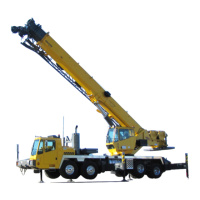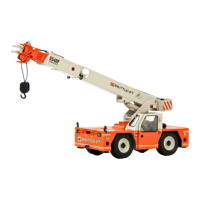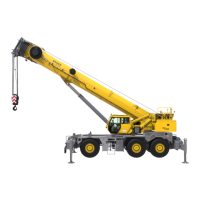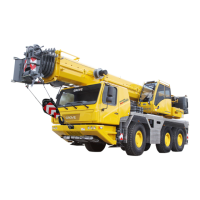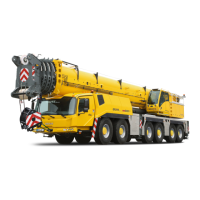4-13
TMS9000-2 OPERATOR MANUAL OPERATING PROCEDURES
Published 02-21-2019, Control # 611-05
ATC Operation
During periods of wheel slip, the Electronic Control Unit
enters an Automatic Traction Control mode. There are
various modes of Automatic Traction Control.
System Operation
• At speeds above 40 km/h (25 mph), the engine is
throttled back via the data link to control wheel spin.
• At speeds below 40 km/h (25 mph), both engine control
and differential brake control are activated as required to
control wheel slip. Once triggered, differential braking
mode remains active regardless of vehicle speed.
• The ATC off-road switch, (4) (Figure 4-14), allows
greater wheel spin (more torque) when activated. It is
intended for adverse conditions, usually off-highway.
The switch turns on ATC off-road when pushed once
and off when pushed a second time and whenever the
system goes through a power-up cycle.
The ATC Indicator, (2) (Figure 4-14), will flash rapidly when
ATC is operating.
Component Function
When brake control is utilized, the ATC valve is activated,
diverting supply tank air to the modulator valves on the drive
axle(s). The ECU then activates the appropriate solenoids in
order to apply a brake force to the spinning wheel. The
Automatic Traction Control System cannot increase traction
to a particular wheel; it can only utilize the available traction.
Traction Control Power-Up Sequence
The ECU will illuminate the Automatic Traction Control (ATC)
lamp, (2) (Figure 4-14), for approximately 2.5 seconds when
ignition power is applied, after which the lamp will extinguish,
if no diagnostic trouble codes are detected.
The ECU will illuminate the ATC Indicator Lamp whenever
ATC is disabled due to a diagnostic trouble code or when the
ECU has been placed in the off-road mode. Refer to the
Service Manual for trouble code information.
Traction Control Switch Operation
To activate ATC off-road mode, push the bottom of the ABS/
Traction Control switch, (4) (Figure 4-14), once. When the
ECU is placed in the ATC off-road mode, the ATC indicator
lamp will flash slowly at a rate of 1.0 seconds on, 1.5
seconds off to notify the vehicle operator that the off-road
mode is active.
Pushing the switch again will turn off the ATC off-road mode.
Thermal (Brake Heat) Protection
To prevent excessive brake and drum temperature resulting
from brake activity, ATC incorporates a brake temperature
estimation algorithm to determine when differential braking
mode should be suspended. The differential braking function
is re-enabled after a cool-down period.
ABS/ATC Partial Shutdown
Depending which component the trouble code is detected
on, the ABS and ATC functions may be fully or partially
disabled. Even with the ABS indicator lamp on, the ECU may
still provide ABS function on wheels that are not affected.
The ECU should be serviced as soon as possible. Refer to
the Service Manual for more information.
ENGINE OPERATION
Starting and shutdown procedures for most diesel engines
generally follow the same pattern. Therefore, the following
procedures can be applied, except where specific
differences are noted. (Refer to the applicable engine
manufacturer’s manual for detailed procedures).
Starting Procedure
1. Set the parking brake to ON, position the transmission to
neutral, and depress the service brake foot pedal.
NOTE: The engine will not crank unless the transmission
shift lever is in neutral.
2. Turn the ignition switch to START and release
immediately when the engine starts.
3. When starting has been accomplished, check the
engine instruments for proper indications.
CAUTION
Before starting the engine, ensure the transmission is in
neutral and the parking brake is applied.
CAUTION
Never crank the engine for more than 30 seconds during
an attempted start. If the engine fails to start after 30
seconds, allow the starter motor to cool for approximately
two minutes before attempting another start.
If the engine fails to start after four attempts, correct the
malfunction before attempting any further starts.
WARNING
Ensure both air system pressures are in the normal
operating range prior to disengaging the parking brake.

